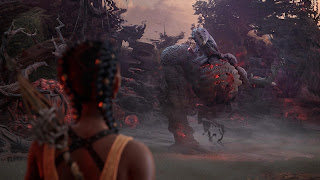South of Midnight - just south of greatness
Like the romanticized American southern manners, South of Midnight greets you with its charms at first sight. The stellar music, the art direction, the stop motion-like animation feel like ice-cold lemonade on a sweltering New Orleans night. But, again, like the romanticized American southern manners, something problematic often lurks underneath the charm.
From the very first intro animation, one thing becomes clear: the game oozes atmosphere. The animation which purposefully skips frames (much like the Spider-verse films do) blends with faily good but definitelly well accented voiceovers, moody guitar blues, haunting banjos and gospel-like choirs. It all swirls together like moonlight and fog, pulling you deeper into the bayou levels, where stories with that southern, almost voodoo/hoodoo vibe unfold through simple puzzles, decent platforming and bad combat (but we'll get to that later). The soundtrack would definitely steal the show, if the rest of the game's charms didn't meet it on equal footing.
The art style is definitely the game's biggest draw, despite the story trying its best to be the standout feature. It has an almost rugged realistically cartoony edge (again, like the Spider-Verse films), complete with intentional frame skipping.
However, in trying to reconcile this art-style with today's demands of smooth 60+fps and gameplay requiring smooth and easy-to-read animations, the game doesn't do itself many favors. More often than not, it gets stuck somewhere in the middle, with the framerate fluctuating depending on what model or animation is happening on screen. This lack of commitment to a consistent approach ends up making the skips feel unintentional and annoying at times, and sadly the art style only truly shines in cutscenes, when it succeeds in giving off that eerie, puppetry vibe.
The story begins as a personal journey for Hazel, our YA main character, to find a loved one after a disaster. Not before long, she begins discovering her unique powers as a Weaver, a person able to see the strands of fate and history to uncover the past and heal its wounds. And, conveniently, to navigate platforming sessions like her life depended on it (and often it does) as well as fight manifestations of old pain called Haints and cleanse the tangle of negative emotions that spawns them.
The gameplay itself loops through 2 distinct cycles: exploration and platforming, and combat.
The first is enjoyable, if not very standard, formulaic stuff. There's your jumping sections, your exploration sections, your basic puzzles, using abilities like double jumping, boosting, gliding etc to navigate levels, uncover tidbits of story and hunt down ability points. What elevates this is the aforementioned atmosphere and level design: swamps, mountaintops, caves, burrows, abandoned towns, dreams themselves, they all lend their geography towards the progression of unfolding plotlines and environmental storytelling, in a way being reminiscent of the template for the genre, Prince of Persia.
Unlike PoP though, the second gameplay cycle of the game, combat, strongly harms the overall experience.
All the combat in the game (including boss fights) occurs in closed-off arenas. And, while the enemy design of each Haint type and the bosses is unique and scary, the mechanics of combat itself feel uninspired at best, needless at worst. All the goodwill the game builds up with its many charms gets swiftly stomped out by mediocre combat that feels like it's there simply to tick a box.
There's no real rhythm or fluidity in the combat - attacks and abilities often don't seem to mesh and flow together, making it an awkward affair. Haze's inability to block attacks, limited dodging and limited abilities and arsenal, combined with the fact that most enemies will not react to your attacks beyond losing hitpoints and will execute attack patterns and animations in the middle of your combo only exacerbates this.
If I had to summarise all of the above in just a few words, it would be these: South of Midnight shines brightest when it leans into its charms and strengths, and would have been a fantastic narrative driven exploration game. It's just a shame that it tries to be something else.








Comments
Post a Comment